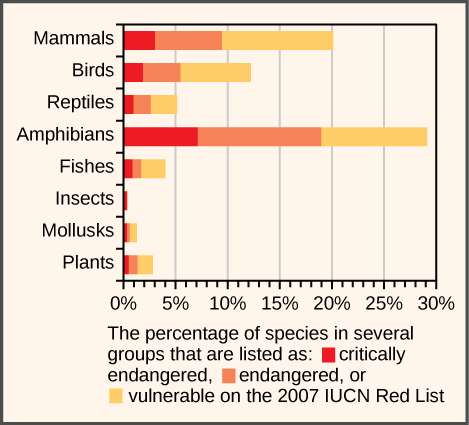| << Chapter < Page | Chapter >> Page > |
Preserving biodiversity is an extraordinary challenge that must be met by greater understanding of biodiversity itself, changes in human behavior and beliefs, and various preservation strategies.
Numerous computer databases now provide information about named species and a framework for adding new species. However, at the present rate of description of new species, it will take close to 500 years before the complete catalog of life is known. Many, perhaps most, species on the planet do not have that much time.
There is also the problem of understanding which species known to science are threatened and to what degree they are threatened. This task is carried out by the non-profit IUCN which, as previously mentioned, maintains the Red List—an online listing of endangered species categorized by taxonomy, type of threat, and other criteria ( [link] ). The Red List is supported by scientific research. In 2011, the list contained 61,000 species, all with supporting documentation.

Which of the following statements is not supported by this graph?
Legislation throughout the world has been enacted to protect species. The legislation includes international treaties as well as national and state laws. The Convention on International Trade in Endangered Species of Wild Fauna and Flora (CITES) treaty came into force in 1975. The treaty, and the national legislation that supports it, provides a legal framework for preventing approximately 33,000 listed species from being transported across nations’ borders, thus protecting them from being caught or killed when international trade is involved. The treaty is limited in its reach because it only deals with international movement of organisms or their parts. It is also limited by various countries’ ability or willingness to enforce the treaty and supporting legislation. The illegal trade in organisms and their parts is probably a market in the hundreds of millions of dollars. Illegal wildlife trade is monitored by another non-profit: Trade Records Analysis of Flora and Fauna in Commerce (TRAFFIC).
Within many countries there are laws that protect endangered species and regulate hunting and fishing. In the United States, the Endangered Species Act (ESA) was enacted in 1973. Species at risk are listed by the Act; the U.S. Fish&Wildlife Service is required by law to develop management plans that protect the listed species and bring them back to sustainable numbers. The Act, and others like it in other countries, is a useful tool, but it suffers because it is often difficult to get a species listed, or to get an effective management plan in place once it is listed. Additionally, species may be controversially taken off the list without necessarily having had a change in their situation. More fundamentally, the approach to protecting individual species rather than entire ecosystems is both inefficient and focuses efforts on a few highly visible and often charismatic species, perhaps at the expense of other species that go unprotected. At the same time, the Act has a critical habitat provision outlined in the recovery mechanism that may benefit species other than the one targeted for management.

Notification Switch
Would you like to follow the 'Bi 101 for lbcc ilearn campus' conversation and receive update notifications?